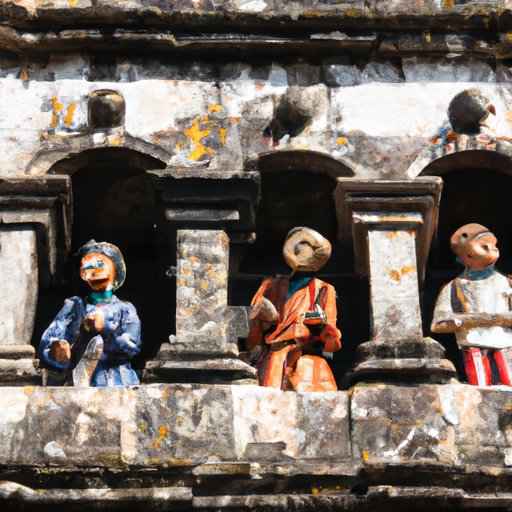Introduction
Samaritans have been regarded as a marginalized and rejected community across many cultures and periods, from the ancient Middle East to modern-day. In Biblical times, the term “Samaritan” was often used as a derogatory term to negatively label individuals and groups. But what led to this stigma and how has it evolved over time? In this article, we’ll explore the historical, cultural, and religious dimensions of why Samaritans were considered unclean.
The historical and cultural context of the Samaritans
The Samaritans’ origins date back to the time of the Assyrian exile in the 8th century BCE, when non-Judean inhabitants of Israel were transferred to Samaria by the Assyrian Empire. The Samaritans were known for practicing a unique form of monotheistic religion, which shared similarities with Judaism. However, they were still deemed as outsiders and mistrusted by the Judeans who remained in Jerusalem.
During the Second Temple period, Samaritan-Jewish relations remained tense, with each group believing they were the rightful heirs to the land of Israel. Samaritans insisted that Mount Gerizim, located in their northern territory, was the true site of worship. In contrast, Jews maintained that the holy temple in Jerusalem was the center of the universe, and looked down upon the Samaritans’ ideas of worship.
The Babylonian exile in the 6th century BCE also had a significant impact on the Samaritans, as it led to the emergence of the Jewish canon of scripture and the formation of a distinct Jewish identity. In contrast, the Samaritans retained a version of the Pentateuch that differed from that of the Jewish tradition.
The differences in religious practices and beliefs between the Samaritans and the Jews
Samaritans and Jews held different beliefs about many basic theological and ritualistic practices. While Jews believed in the existence of the Prophets, and held that the Law and the Prophets formed the religious basis for Judaism. Samaritans, on the other hand, only accepted the first five books of the Hebrew Bible as their Torah.
Samaritans also had a distinct way of practicing certain religious rituals, including the Passover, which the Jewish people have celebrated for thousands of years. The Samaritan Passover, for instance, was celebrated on Mount Gerizim and involved the slaughtering of a lamb and public prayers.
The most significant distinguishing feature between the two groups was the place of worship. Jews recognized Jerusalem as their central holy site, specifically the Second Temple, whereas the Samaritans maintained that the center of worship was Mount Gerizim. The truce between the two communities would be brokered only when the Second Temple was destroyed by the Romans in 70 CE.
The influence of political and social factors on the perception of the Samaritans
The Babylonian and Assyrian exiles took a significant toll on the community of the Samaritans, with many socially and economically disinherited. Samaritans were consistently marginalized and often faced discrimination. Their origins paired with their religious beliefs further amplified the mistrust that surrounded this community.
During and after the Maccabean rebellion (167–160 BCE), which is regarded as forming the foundation the Jewish worship practices, tensions between the two groups increased. Samaritans were viewed as hostile outsiders, and the conflict between the two groups was amplified under the Roman occupation of Palestine. Emperor Pilate’s installation of Roman standards in Jerusalem further escalated tension, which would lead to the genocide of 30,000 Samaritans during the Passover feast of 36 C.E.
Experiences and instances that perpetuated the negative stereotypes of Samaritans
The New Testament shows that in early Christianity literature, Samaritans were depicted as antithetical and unclean. They were portrayed as religiously confused, greedy and considered ritually unclean. This image was perpetuated in stories like that of the Good Samaritan, many scholars believe that this was intentionally used to shock and surprise the audience.
In the Old Testament, Samaritans were regarded as vile people who indulged in sexual immorality and idol worship. At the very basic level, this is the single most significant reason why Jews did not consider Samaritans to he ritually clean.
The significance of the portrayal of Samaritans in religious texts
Scholars have contrasted the highly negative portrayal of Samaritans in the Bible with more positive depictions of Samaritan religion in later rabbinic literature. This reflects a change in attitudes among post-biblical Jewish scholars towards Samaritan identity, reflecting more positive application of their teachings.
However, the legacy of negativity attached to the image of Samaritans would linger, influencing the contemporary perception of the community.

Current perceptions and understanding about Samaritans in modern times
The modern-day Samaritan community is a fascinating blend of tradition and culture. People of the community are relatively rare and live in several towns and villages, mostly in the Middle East. Their customs involve the use of their unique biblical calendar and maintaining thousands of unreadable scrolls that hold their ancient writer’s writing. Despite the importance of their tradition, today the Samaritans are a dwindling people.
Current issues faced by Samaritans include cultural preservation and demographic decline. The community is making efforts to preserve their cultural heritage through cultural festivals, community support, and outreach initiatives.
How the view towards Samaritans has changed over time
Over time, the view of Samaritans has evolved, from their ancient rejection to modern attempts at cultural preservation. While it is clear that Samaritans have faced significant discrimination due to religious, cultural and political differences, today, society is gradually coming to understand and respect their unique identity.
Conclusion
In conclusion, understanding the historical, religious, and social dimensions of the Samaritan community is essential for us to shed light on and move beyond the stereotypes that cause conflict between cultures and identities. Samaritans’ continuing survival is a testament to their culture’s resilience and illustrates the challenges faced by marginalized communities today and throughout history. Recognizing and respecting the Samaritan identity as a unique cultural heritage is essential for continuously promoting a culture of intercultural understanding and respect.
With a rich and unique cultural identity, the Samaritans represent a fascinating and important component of our world heritage. Overcoming negative stereotypes and understanding their history is critical to building a more tolerant and inclusive society, one that acknowledges the profound diversity of human culture.
